TELLING SNOW
/20 Comments/in Gardening, Pests, Pruning/by Lee ReichI Grow Taller
“Make hay while the sun shines” is fine advice in its season. For winter, how about? “Prune while the snow is high and firm.”
My apple and pear trees are semi-dwarf, presently ranging from seven to eleven feet tall. Even though I have a pole pruner and various long-reach pruning tools, I still carry my three-legged orchard ladder out to the trees with me to work on their upper branches. Sometimes you have to get your eyes and arms and hands right up near where you’re actually cutting.
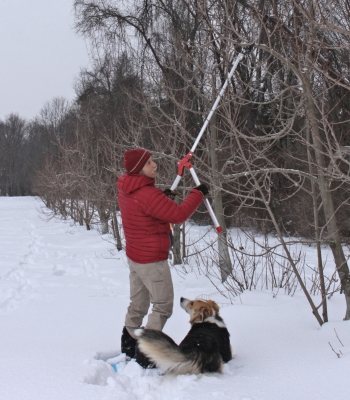
A few years ago, as I was looking out the window and admiring the foot or of snow on the ground, I realized that all that snow could give me a literal leg up on pruning. If I stayed on top of the snow, that is. While the snow was still soft, I was able to do this by strapping on a pair of snowshoes, which I bought, used, just for this purpose. (For travel through snow, I prefer to glide, on skis.) When the snow melted a little and then froze, the icy crust that formed was able to support my weight sans snowshoes.
In any case, when there’s a good depth on the ground, such as today, I gather my tools – minus the stepladder – and walk tall out to the trees.
Top Down Pruning
Plants, like other creatures, have hormones, and a hormone (called auxin) in every plant generally coaxes uppermost portions to grow most vigorously. Which is why old apple trees become topheavy, with most shoot growth high up. The upshot of this habit is that most fruit is borne high in the branches, out of reach, and lower branches are shaded to become unproductive and prone to disease.
Ideally, then, the best place to start pruning is with the most vigorous branches, highest in the tree. That’s also the last place you want to start if you’re standing at ground level. Perched atop a good depth of snow next to my smaller trees, starting near the top was much easier.
If I get high enough (in the tree), I can imagine that I’m hovering above the branches, looking at them from the perspective of ol’ Sol, which is a good perspective for a grower of fruit trees. This allows a more objective perspective on which branches are going to be blocking light or otherwise cramping others for space.

Letting more light and air in among the branches and, at the same time removing potential fruits with pruned branches, channels more of each tree’s energy into perfecting those fruits that remain. Remaining fruits are then healthier, larger, and more flavorful, especially for naturally larger fruits such as apples, pears, and peaches
Snow Tales
The snow is a blank canvas that records some winter activities. My dogs’ footprints are obvious and telling. They are provincial in their travels, having beaten paths from their doghouses, where they sleep, to the driveway, where they greet humanity, and to the deck, where they lie in the sun.
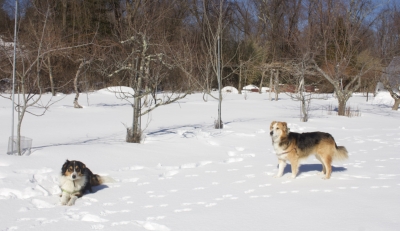
Daisy and Sammy at work
Less frequent are their forays out into the hay field to do their business and to see if anything interesting is creeping around out there.
The small, padded footprints of my cat hasn’t beaten out paths. The cat more randomly explores out-of-the-way nooks and crannies. She also likes to steer clear of the dogs, who consider her just another small animal worth chasing.
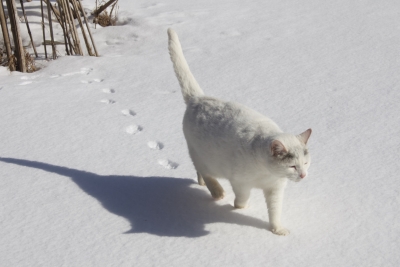
Gracie at work
The distinctive footprints that I’m keeping the closest eye out for are those of rabbits and deer. Now, about when I typically delude myself that all danger has past, periods of warmer weather start coaxing rabbits to wander about and eye my trees and shrubs as food. Now is also when cottontail rabbits start reproducing, the first of up to five litters for this year, with a half dozen or so bunnies per litter! Very cute, but deadly to my plants.
This winter, a couple of deep snows either brought deer here or displayed their abundance with tracks in the snow. For the rabbits, who feed on young trees and low branches, I sometimes make up a spray of white latex paint, water, eggs, cinnamon, and hot pepper. That needs to be re-applied about now. Traps I set out for them are thoroughly and safely (for the rabbits) buried in snow. Perhaps I’ll dig them out and re-set them.
The uncluttered expanse of snow makes it easy to see where I put my pruning tools as I prune the apples and pears. The snow also makes it easy to see where I drop the prunings.
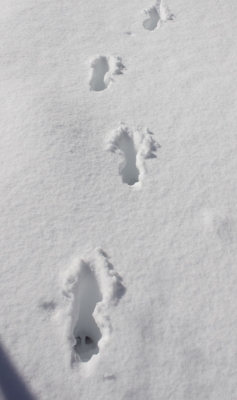
Deer tracks in the snow
And why do I care where I drop my prunings? Because I can then quickly look at them to see if any bark has been gnawed off those freshly cut branches. And what would gnaw bark off those freshly cut branches. Rabbits!
No sign of rabbits – yet, at least – on those prunings as well as on tracks in the snow. Thank you Gracie (my cat).
The dogs’ are supposed to be keeping deer at bay, but do so only if they are out and about when deer are around. This year I’ve been relying on Bobbex repellent, which I spray monthly on branches that would be within reach of the deer. So far, the sprays have been 100% effective even on trees with deer tracks right beside them in the snow.
Get Ready for Spring
I will be hosting a WEEDLESS GARDENING webinar on Monday, February 22nd for $35. It will run from 7-8:30 pm EST and there will be plenty of opportunity to ask questions. For details, go to www.leereich.com/workshops. Or trust me, and go right to registration (required) at https://us02web.zoom.us/webinar/register/WN_WqSCBtOGTqqjGgbOHOuxfg
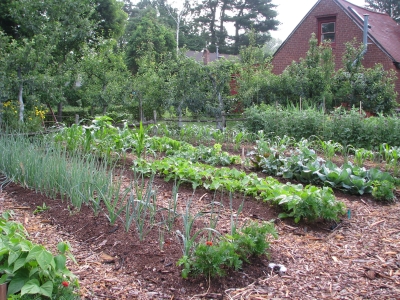
GET YOUR DUCKS IN ORDER FOR SPRING
/2 Comments/in Gardening/by Lee ReichWEEDLESS GARDENING WORKSHOP/WEBINAR
Presentation by Lee Reich (MS, PhD, researcher in soil and plants for the USDA and Cornell University, decade-long composter, and farmdener*)
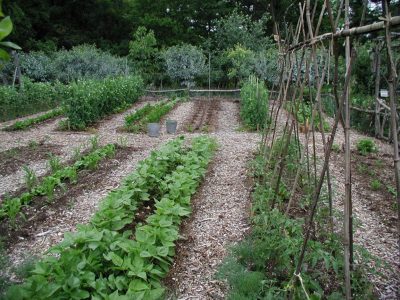
Introducing a novel way of caring for the soil, a 4-part system that minimizes weed problems and maintains healthy plants and soil. Learn how to apply this system to establish new plantings as well as to maintain existing plantings. The principles and practices are rooted in the latest agricultural research and are also applicable to sustainable, small farm systems.
Success comes from emulating rather than fighting Mother Nature who, as C. D. Warner wrote (My Summer in the Garden, 1887), “is at it early and late, and all night; never tiring, nor showing the least sign of exhaustion.”
Space for this workshop/webinar is limited so registration is necessary. Sign up soon to assure yourself a space.
Date: February 22, 2021
Time: 7-8:30 pm EST
Cost: $35
Register for this webinar at:
https://us02web.zoom.us/webinar/register/WN_WqSCBtOGTqqjGgbOHOuxfg
After registering, you will receive a confirmation email containing information about joining the webinar.
*A farmdener is more than a gardener and less than a farmer.
FROM GROCERS’ SHELVES TO MY FLOWER POTS
/6 Comments/in Fruit, Houseplants/by Lee ReichExotic, tropical fruits are turning up more and more frequently on grocers’ shelves these days: dates, papayas, guavas, and others. I look upon these fruits opportunistically, because within each lies dormant seeds that can be coaxed to become exotic, if not beautiful, indoor plants that might even provide a delicious fruit harvest. Such plants provide a break from the humdrum of spider plants, philodendrons, and Swedish ivies.
Seeds of tropical fruits usually germinate best if planted as soon as the fruits are eaten. Cold-climate fruits, in contrast, have innate inhibitors that prevent seed germination until they feel that winter is over.
So all that’s necessary to grow most tropical fruits is to wash their seeds and sow them in potting soil, using the old rule of thumb of burying a seed to twice its depth. And then wait.
DELICIOUS, BUT HARD TO SAY
I have harvested fruit grown from the seed of a grocery store bought pineapple guava, also known as the feijoa (pronounced FAY-HO’-A, from the generic part of its unwieldy Latin name, Feijoa sellowiana, recently change to Aca sellowiana). The fresh seeds, scooped from the fruit, germinated and grew.
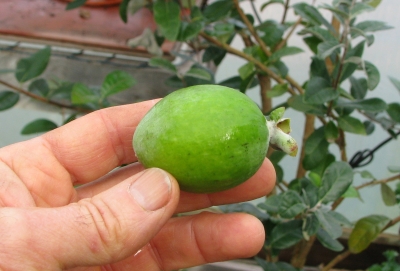
Feijoa seems to me an ideal plant to grow. Even outdoors where it’s native, the tree is small, so does not mind being kept five foot high in a pot which can be carried indoors during our frigid winters. The plant is subtropical rather than tropical, so can stand a bit of cold, down to about 10 degrees Fahrenheit.
Feijoa has leaves which are shiny and dark green on their upper surfaces, and felt-like and silvery on their lower surfaces. My plant spends winter decorating a sunny, south-facing window in a cool room in my house. The flowers’ stamens are arranged in a tuft like a red bottlebrush, and the petals are thick, purple and white. Those petals are very edible and very delicious, with a sweet, pineapple-minty flavor.
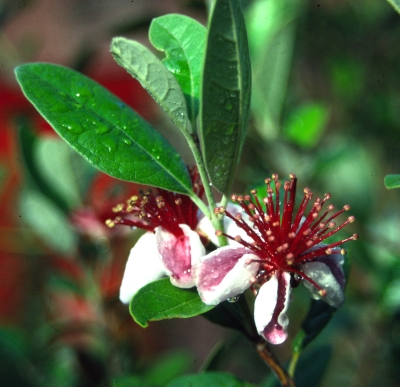
But best of all is the fruit itself. Beneath the thin skin is a gelatinous center with a spicy pineapple flavor. My feijoa plant hasn’t provided sufficient harvest to satisfy my feijoa-ish needs.
A LONG TIME TO WAIT FOR A DATE
The waiting period for a date fruit can be a long time, even a long time for the seed to germinate. But stop for a moment and think about deserts, where dates are native. Should a date seed send up a leafy shoot with the first hint of moisture? Of course not. The dry desert air would dehydrate the sprout in short order. When a date seed germinates, first its thick taproot grows straight downwards, seeking permanent moisture, long before even a small sprout appears aboveground.
I once planted some date seeds (first making sure they came from unpasteurized dates). Knowing that I would have a long wait before the first sprouts emerged, I planned to watch the roots grow to keep myself from becoming too impatient. I put an inch of water in the bottom of a peanut butter jar, slid a tube of rolled-up blotting paper (watercolor paining paper would probably also work well) into the jar, and then “planted” the date seeds halfway up the jar, pressed between the glass and the paper.
As predicted, the roots appeared and thrust downwards before there was any sign of a shoot. When I eventually became bored watching the progress of the roots, I planted the seedlings in potting soil.
Leaves finally did poke up through the soil, an event that was far from dramatic. Each emerging seedling looked like a green toothpick stuck into the soil. In time, the “toothpicks” did unfurl into a succession of fan-like leaves which would match any ordinary houseplant for beauty and tolerance of neglect.
Fruit production from a homegrown date palm is well-nigh impossible. The plant grows slowly. Climate here in northeastern U.S. is suboptimal, to say the least. And only female plants produce fruit, so enough plants would have to be grown to flowering size to ensure at least one male (for pollination) and one female (for fruit).


Date palm orchard, Israel
PA-PA-PAPAYA
One winter day a number of years ago, I planted seeds from a papaya fruit I had just eaten. Having seen papayas growing wild throughout the tropics, I assumed they would not be hard to grow. I scooped the seeds from the fruit, washed them to remove their gelatinous coating, and sowed them immediately.
Growing papayas proved as challenging as growing dates. In this case, not only were the seeds slow to germinate, but the young seedlings were extremely fragile and subject to damping-off. I nursed a single survivor beyond this wimpy initial stage, and, in time, it began to grow robustly.

Potted papaya at Chanticleer
In the tropics, papayas are short-lived trees that often bear their first fruits as early as eleven months after seed is sown. My papaya tree was outgrowing its one-foot-diameter pot when warm weather arrived, so I decided to plant it outside and hope for fruit. Imagine the astonishment of my neighbor, who grew up in Florida, when he saw a tropical papaya tree in my garden!
Unfortunately, my plant succumbed to the first fall frost before it had a chance to fruit. Fruiting would have been chancy anyway, because papaya plants come in various combinations of sexes. Some plants have only male flowers; others only female flowers; and still others have bisexual flowers. Papaya have been known to switch their sex under certain conditions. To fruit, my single plant would have needed bisexual flowers, which remained so.
The feijoa, date palm, and the papaya take their place in the long line of avocados, prickly pears, tree tomatoes, kumquats, lemons, tangerines and other forgotten grocery store plants that once were and, in some cases, still are part of my indoor jungle.

Lemon, Kumquat, Opuntia, Tree tomato

